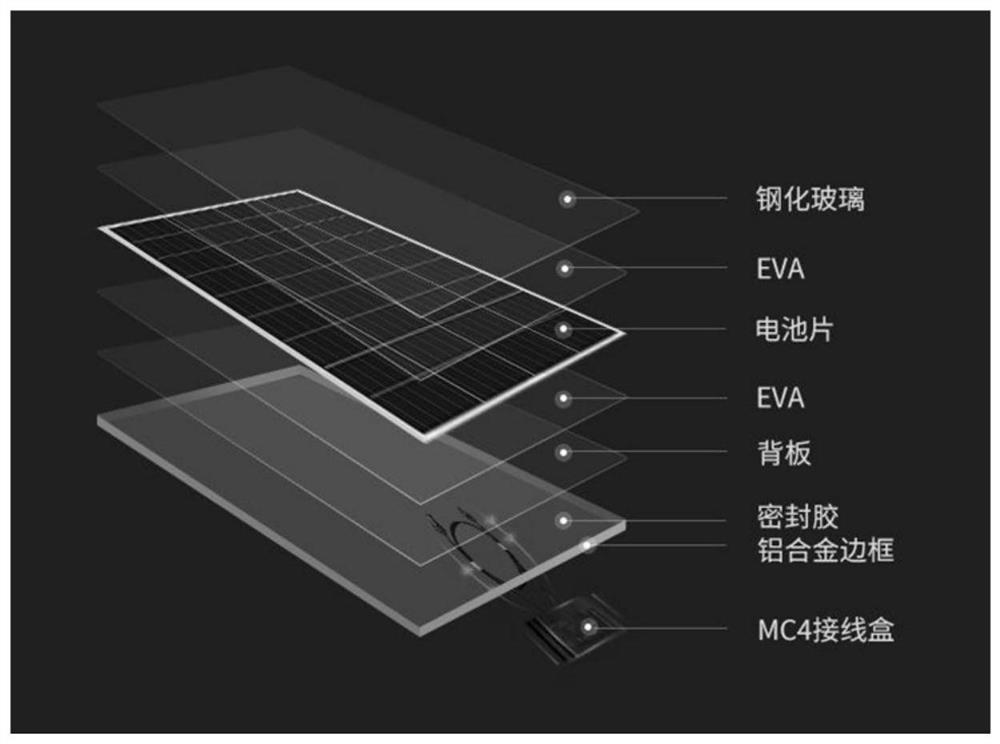Method for separating and recycling leftover materials of composite EVA (Ethylene Vinyl Acetate) adhesive film of solar back plate
A technology of a solar back sheet and a recycling method, which is applied in the field of separation and recycling of scraps of solar back sheet composite EVA film, can solve the problems of inability to dissociate the EVA hot melt adhesive film, and the inability to complete the separation of the back sheet and composite EVA film leftovers, etc. , to achieve the effect of complete recovery and high separation efficiency
- Summary
- Abstract
- Description
- Claims
- Application Information
AI Technical Summary
Problems solved by technology
Method used
Image
Examples
Embodiment 1
[0026] (1) By weight, 100 parts of solar backplane composite EVA film scraps are separated by 20 parts of water, 50 parts of sodium hydroxide, 5 parts of JFC-1, 60 parts of acetone and 1 part of sodium dihydrogen phosphate solution, after 0.1 hour treatment at 30°C, the separated backplane membrane was cleaned with water;
[0027] (2) Choose BaCl 2 The aqueous solution is used as the centrate, and the density of the centrate at 5°C is adjusted to 1.2 g / cm 3 ;
[0028] (3) Add the mixed membrane obtained in (1) and 200 parts of water into the centrifuge, centrifuge and let it stand, and then obtain the EVA film floating on the water surface after separation and cleaning; then mix the remaining material with 200 parts The centrifuged liquid obtained in part (2) was put into a centrifuge, centrifuged at 10 rpm for 0.1 minute, and left to stand for 0.1 hour. After separation and cleaning, the fluorine-containing material and PET material were separated.
Embodiment 2
[0030] (1) By weight, put 100 parts of solar backplane composite EVA film scraps through a separation liquid composed of 500 parts of water, 1 part of potassium hydroxide, 0.1 part of JFC-E, 10 parts of ethanol and 30 parts of sodium tripolyphosphate, After being treated at 100°C for 72 hours, the separated backsheet membrane was cleaned with water;
[0031] (2) Select CaCl 2 High saline solution is used as the centrifugal separation liquid, and the density of the centrifugal separation liquid at 80°C is adjusted to 2.0g / cm 3 ;
[0032] (3) Add the mixed membrane obtained in (1) and 30 parts of water into the centrifuge, centrifuge and let it stand, then separate and wash to obtain the EVA film floating on the water surface; then mix the remaining material with 30 parts The centrifuged solution obtained in part (2) was put into a centrifuge, centrifuged at 20,000 rpm for 60 minutes, and allowed to stand for 100 hours, then the fluorine-containing material and PET material we...
Embodiment 3
[0034] (1) By weight, put 100 parts of solar backplane composite EVA film scraps through a separation liquid composed of 100 parts of water, 20 parts of calcium hydroxide, 1 part of JFC-2, 20 parts of methanol and 15 parts of sodium pyrophosphate. After 10 hours of treatment at 50°C, the separated backsheet membrane was cleaned with water;
[0035] (2) Select KCl high-salt solution as the centrifugation liquid, and adjust the density of the centrifugation liquid at 20°C to 1.5g / cm 3 ;
[0036] (3) Add the mixed membrane obtained in (1) and 2000 parts of water into the centrifuge, centrifuge and let it stand, then separate and wash to obtain the EVA film floating on the water surface; then mix the remaining material with 2000 parts The centrifuged liquid obtained in part (2) was put into a centrifuge, centrifuged at 10,000 rpm for 5 minutes, and allowed to stand for 0.5 minutes to separate the fluorine-containing material and PET material in layers.
PUM
| Property | Measurement | Unit |
|---|---|---|
| Density | aaaaa | aaaaa |
| Density | aaaaa | aaaaa |
| Density | aaaaa | aaaaa |
Abstract
Description
Claims
Application Information
 Login to View More
Login to View More - R&D
- Intellectual Property
- Life Sciences
- Materials
- Tech Scout
- Unparalleled Data Quality
- Higher Quality Content
- 60% Fewer Hallucinations
Browse by: Latest US Patents, China's latest patents, Technical Efficacy Thesaurus, Application Domain, Technology Topic, Popular Technical Reports.
© 2025 PatSnap. All rights reserved.Legal|Privacy policy|Modern Slavery Act Transparency Statement|Sitemap|About US| Contact US: help@patsnap.com

